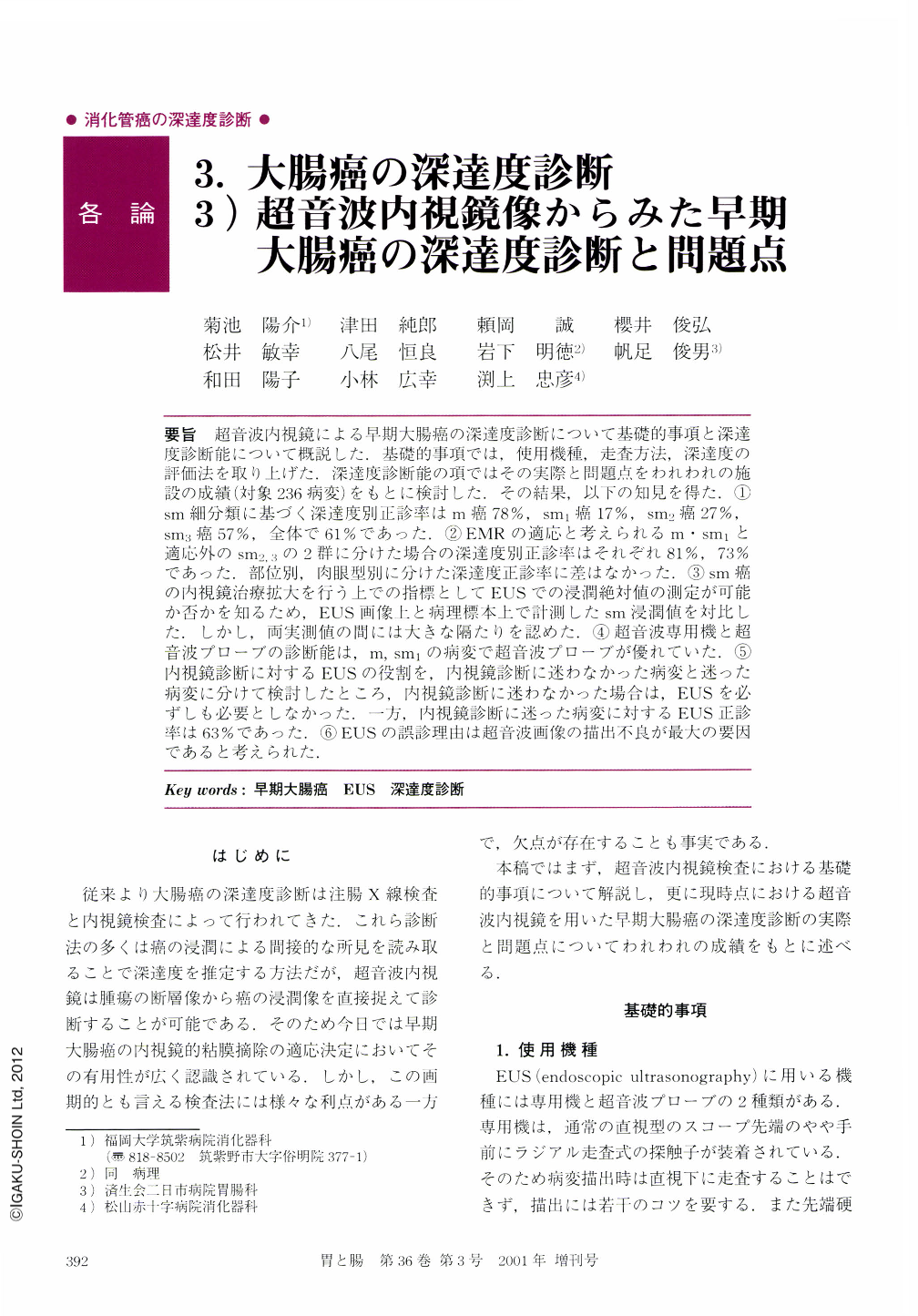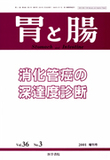Japanese
English
- 有料閲覧
- Abstract 文献概要
- 1ページ目 Look Inside
- サイト内被引用 Cited by
要旨 超音波内視鏡による早期大腸癌の深達度診断について基礎的事項と深達度診断能について概説した.基礎的事項では,使用機種,走査方法,深達度の評価法を取り上げた.深達度診断能の項ではその実際と問題点をわれわれの施設の成績(対象236病変)をもとに検討した.その結果,以下の知見を得た.①sm細分類に基づく深達度別正診率はm癌78%,sm1癌17%,sm2癌27%,sm3癌57%,全体で61%であった.②EMRの適応と考えられるm・sm1と適応外のsm2,3の2群に分けた場合の深達度別正診率はそれぞれ81%,73%であった.部位別,肉眼型別に分けた深達度正診率に差はなかった.③sm癌の内視鏡治療拡大を行う上での指標としてEUSでの浸潤絶対値の測定が可能か否かを知るため,EUS画像上と病理標本上で計測したsm浸潤値を対比した.しかし,両実測値の間には大きな隔たりを認めた.④超音波専用機と超音波プローブの診断能は,m,sm1の病変で超音波プローブが優れていた.⑤内視鏡診断に対するEUSの役割を,内視鏡診断に迷わなかった病変と迷った病変に分けて検討したところ,内視鏡診断に迷わなかった場合は,EUSを必ずしも必要としなかった.一方,内視鏡診断に迷った病変に対するEUS正診率は63%であった.⑥EUSの誤診理由は超音波画像の描出不良が最大の要因であると考えられた.
We explained basic facts and the possibility of diagnosing the depth of infiltration in early colorectal cancer investigated by endoscopic ultrasonography (EUS). In “basic facts”, we described instruments of EUS and treatment indications for respective lesions, techniques, evaluation of the depth of infiltration, diagnostic criteria. In “diagnostic possibility”, we explained our results for the actual lesions obtained by EUS. Altogether 236 lesions were included for material. They were adenomas and early cancers. The conclusions were as follows:
1. The possibility of correct diagnosis based on the subdivision of the degree of submucosal invasion was 61% overall. 78% in m, 17% in sm1, 27% in sm2, and 57% in sm3. Adenomas were included in intramucosal cancer.
2. The possibility of correct diagnosis of m, and sm1 cancers, which are considered to indicate the need for endoscopic resection, was 81% overall. In sm2 and sm3 cancers, which don't indicate a need for resection, we could diagnose 73% of the lesions.
3. There was no correlation between the possibility of correct diagnosis and the sites or shapes of the lesions.
4. There was a difference between the endosonographical measurements of submucosal infiltration and the histological measurements.
5. Endosonography used exclusively for diagnosing the depth of infiltration in m, and sm1 cancer was more effective than the miniture probe, which is used through the biopsy channel.
6. We divided the lesions into two groups; the lesions with certain findings and those with uncertain findings. We compared the diagnostic possibility between these two groups. The group with certain findings was able to be diagnosed acurately and at a high frequency using only endoscopy itself. The lesions of this group did not need further diagnosis using EUS. On the other hand, the possibility of correct diagnosis of the depth of invasion in the group with uncertain findings was very limited and only 63% of the diagnoses were correct.
7. Substandard quality of the view obtained was the main factor responsible for misdiagnosis when using EUS.
8. In making good use of the qualities of EUS, it is considered that we should select the lesions for investigation and make an effort to obtain a good view in order to diagnose the depth of infiltration in early colorectal cancer.

Copyright © 2001, Igaku-Shoin Ltd. All rights reserved.


